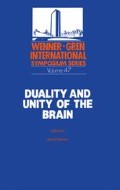Abstract
A variety of findings suggest a highly consistent pattern of hemispheric specialization in dextrals, characterized by left hemisphere superiority for processes utilized in language tasks and right hemisphere superiority for processes utilized in spatial tasks as well as in the perception of non-verbal auditory stimuli. Evidence for this pattern comes from studies of the cognitive abilities of the isolated hemispheres of commissurotomy patients (e.g., Levy et al., 1972; Sperry, 1974), from the rarity of aphasic symptoms following right hemisphere damage in dextrals (e.g., Weisenburg & McBride, 1935; Kimura, 1983), as well as from sodium amytal tests which indicate that 95–99% of dextrals have language output functions lateralized to the left hemisphere (e.g., Wada & Rasmussen, 1960; Rasmussen & Milner, 1977).
Access this chapter
Tax calculation will be finalised at checkout
Purchases are for personal use only
Preview
Unable to display preview. Download preview PDF.
References
Blumstein, S., Goodglass, H. and Tarttar, V. (1975). The reliability of ear asymmetry in dichotic listening. Brain and Language, 2, 226–236.
Bryden, M.P. (1982). Laterality: Functional Asymmetry in the In tact Brain. Academic Press, New York.
Burton, L. (1985). Sex Differences in Cerebral Asymmetry. Ph.D. Dissertation, University of Chicago.
Chiarello, C., Dronkers, N.F. and Hardyck, C. (1984). Choosing sides: on the variability of language lateralization in normal subjects. Neuropsychologia, 22, 363–374.
Gur, R.E. and Gur, R.C. (1975). Defense mechanisms, psychosomatic symtomatology, and conjugate lateral eye movements. Journal of Consulting and Clinical Psychology, 43, 416–420.
Gur, R.E. and Reivich, M. (1980). Cognitive task effects on hemispheric blood flow in humans: Evidence for individual differences in hemispheric activation. Brain and Language, 9 ,78–92.
Heilman, K.M. and Van Den Abell, T. (1979). Right hemispheric dominance for mediating cerebral activation. Neuropsychologia, 17, 315–321.
Kimura, D. (1983). Speech representation in an unbiased sample of left-handers. Human Neurobiology, 2 ,147–154.
Kinsbourne, M. (1972). Eye and head turning indicates cerebral lateralization. Science, 176, 539–541.
Kirsner, K. and Schwartz, S. (1986). Words and hemifields: Do the hemispheres enjoy equal opportunity? Brain and Cognition, 5 ,354–361.
Leehey, S.C., Carey, S., Diamond, R. and Cahn, A. (1978). Upright and inverted faces: The right hemisphere knows the difference. Cortex, 14, 411–419.
Levine, S.C., Banich, M.T. and Koch-Weser, M. (1984). Variations in patterns of lateral asymmetry among dextrals. Brain and Cognition, 3 ,317–344.
Levy, J., Heller, W., Banich, M.T. and Burton, L. (1983a). Are variations among right-handers in perceptual asymmetries caused by characteristic arousal differences between hemispheres? Journal of Experimental Psychology: Human Perception and Performance, 9 ,329–359.
Levy, J., Heller, W., Banich, M.T. and Burton, L. (1983b). Asymmetry of perception in free viewing of chimeric faces. Brain and Cognition, 2 ,404–419.
Levy, J., Trevarthen, C. and Sperry, R.W. (1972). Perception of bilateral chimeric figures following hemispheric deconnexion. Brain, 100, 105–118.
Rasmussen, T. and Milner, B. (1977). The role of early left-brain injury in determining lateralization of cerebral speech functions. In Evolution and Lateralization of the Brain. (eds. S.J. Diamond and D.A. Blizard). New York Academy of Science, New York.
Ross, P. and Turkewitz, G. (1981). Individual differences in cerebral asymmetries for facial recognition. Cortex, 17 ,199–214.
Ross-Kossak, P. and Turkewitz, G. (in press). A micro and macro developmental view of the nature of changes in complex information processing: A consideration of changes in hemispheric advantage during familiarization. To appear in Neuropsychology of facial expression. (ed. R. Bruyer). Lawrence Erlbaum, Hillsdale, NJ.
Sperry, R.W. (1974). Lateral specialization in the surgically separated hemispheres. In The neurosciences: Third study program. (eds. F. Schmitt and F. Worden). MIT Press, Cambridge, MA.
Teng, E.L. (1981). Dichotic ear difference is a poor indicator for the functional asymmetry between the cerebral hemispheres. Neuro-psychologia, 19, 235–240.
Trevarthen, C. (1972). Brain bisymmetry and the role of the corpus callosum in behavior and conscious experience. In Cerebral hemisp here relations. (eds. J. Cernacek and F. Podivinsky). Slovak Academy of Science, Bratislava, Czechoslovakia.
Tyler, S.K. and Tucker, D.M. (1982). Anxiety and perceptual structure: Individual differences in neuropsychological function. Journal of Abnormal Psychology, 91, 210–220.
Wada and Rasmussen (1960). Intracarotid injection of sodium amytal and the lateralization of cerebral speech dominance. Experimental and clinical observations. Journal of Neurosurgery, 17, 266–282.
Weisenburg, T. and McBride, K.E. (1935). Aphasia, a clinical and psychological study. Commonwealth Fund, New York.
Wexler, B.E., Halwes, T. and Heniger, G.R. (1981). Use of statistical significance criterion in drawing inferences about hemispheric dominance for language function from dichotic listening data. Brain and Language, 13, 13–18.
White, M. (1969). Laterality differences in perception: A review. Psychological Bulletin, 72 ,387–405.
Yin, R.K. (1969). Looking at upside-down faces. Journal of Experimental Psychology, 81, 141–145.
Editor information
Editors and Affiliations
Rights and permissions
Copyright information
© 1987 The Wenner-Gren Center
About this chapter
Cite this chapter
Levine, S.C., Banich, M.T., Kim, H. (1987). Variations in Arousal Asymmetry: Implications for Face Processing. In: Ottoson, D. (eds) Duality and Unity of the Brain. Wenner-Gren Center International Symposium Series, vol 47. Springer, Boston, MA. https://doi.org/10.1007/978-1-4613-1949-8_14
Download citation
DOI: https://doi.org/10.1007/978-1-4613-1949-8_14
Publisher Name: Springer, Boston, MA
Print ISBN: 978-1-4612-9081-0
Online ISBN: 978-1-4613-1949-8
eBook Packages: Springer Book Archive

